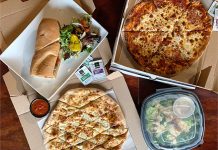Published studies indicate that singles tend to eat out and to bring home take-out food more often than your average family – and it doesn’t take any study to know that most food of convenience, as we’ll refer to it, isn’t the most healthy for those seeking to lose weight.
So, the single most important tactic I’ve learned in my own quest for weight loss is to learn to control my environment. That means committing to eat at home and subsequently making sure that my home is stocked with food items that commit me to healthier cooking. Out goes the leftover pizza boxes, lunch meat, white bread and anything too easy to eat out of a container in the soft glow of the refrigerator light. Modern research indicates that healthy whole foods are the way to go in terms of not only weight loss, but also for general good health.
But where to start in stocking a home for healthy eating environment?
The following is rudimentary breakdown of the things I’ve learned work for me in controlling my kitchen environment, driving me to thus eat healthily, resulting in healthy weight loss. Your doctor or nutritionist could certainly provide plenty more ideas as well as a shopping list catering to your own particular health situation.
Whole grains: quinoa, brown rice, barley and steel-cut oats for oatmeal have become my standards, providing variety and flexibility. I’ll also keep whole grain crackers around if their ingredient list is short and pronounceable.
Oils: extra virgin olive oil, canola oil and peanut oil make up my lipid shopping list, although I will often have small amounts of other oils to finish dishes or to liven up salads.
Proteins: non-farmed frozen salmon filets, frozen cod and frozen tuna are standards in my freezer and quick and easy to defrost and feature in a quick meal. There are debates about the quantity of the healthy fattier fish that people should eat and it also varies by peoples’ health conditions, so I recommend speaking to your doctor about quantities and regularity of eating these generally healthy fish. My freezer routinely also contains Gulf shrimp, frozen edamame and occasionally poultry or red meat. Now, I personally prefer fresh versions of these items, but we’re discussing stocking a kitchen this week.
In terms of other proteins, I also keep a few cheeses, feta and mozzarella generally, eggs, Greek Yogurt, hummus, tinned sardines and crab meat in a pouch or can.
Vegetables: veggies have been key to my own weight loss efforts. But they are also the one category of food that I tend to shop for weekly and prefer fresh. But nutritionally, authorities say frozen vegetables (prepared properly) are as healthy or almost as healthy as fresh and moreso than most canned. Besides edamame, I personally keep frozen peas to toss in almost any grain and a variety of plain, un-sauced others to add into soups and stews. With vegetables, remember, a lot of their health value is based on how they are prepared, so think steamed or sautéed instead of fried or boiled soft; and think olive oil and garlic as opposed to butter. Starchy vegetables haven’t worked for my own purposes, so I skip potatoes and instead keep sweet potatoes on hand. They’re healthier and prepared in a savory fashion, don’t have to have the calorie count we’re used to from Thanksgiving dinner! I also always have onions, garlic and a variety of peppers on hand. I’ve found most dishes that start with a fresh combination of these fragrant and healthy items usually can’t fail.
Legumes: it’s hard to go wrong with this category, and I always keep chick peas, split green peas, kidney beans and several other varieties I like – both canned (make sure to rinse well if you use these) and in dry form (the ideal).
Pantry items: low-sodium chicken or vegetable stock, low-sodium soy sauce, a wide selection of spices, Asian fish sauce, hot sauces (definitely an important secret to livening up healthy dining), buckwheat soba noodles, almonds and other nuts, low-sodium canned tomatoes and a handful of other personal favorite ethnic flavorings.
This is just a very brief look at stocking your kitchen to control your environment and hopefully curb your urge for easy drive-through “food.” I’m sure there are numerous other ways to achieve the same results, but this tactic has worked well for me. In the weeks to come, we’ll explore combining these ingredients to make delicious and nutritious meals that can help with your weight loss goals.
-Michael W. Sasser is Oklahoma Magazine’s senior editor and an award-winning journalist. Neither a medical nor nutrition expert, he shares his personal weight loss journey exclusively with Oklahoma Magazine readers. Reach him at [email protected].


























